Physics
Electron scattering is a powerful tool for studying the structure of nucleons and atomic nuclei. The use of electron beams as a probe provides a clean reaction mechanism that allows the investigation of form factors, polarizabilities, and excitation spectra of hadrons to obtain a detailed description of low-energy phenomena based on quantum chromodynamics. The high precision of the experimental observables that can be achieved also makes possible the search for new particles and interactions beyond the Standard Model of particle physics.
MAGIX is a versatile fixed-target experiment designed for a comprehensive physics program that includes searches for rare events and precision measurements of nuclear observables in the low-energy range. The high-intensity electron beam of an energy recovery accelerator allows the use of a windowless gas target, resulting in large luminosities at negligibly small resolution losses due to multiple scattering, energy losses, and other target effects. The resulting high instrumental accuracy of the spectrometer-based detector system provides unique opportunities for precision measurements in hadron and nuclear physics. Consistent optimization for low particle energies even enables accurate cross section measurements of key reactions in the field of nuclear astrophysics. Furthermore, the high luminosities that can be achieved at the MAGIX interaction point, combined with the experiment's precision detector system, make MAGIX an ideal setup for searching for extremely rare interactions of “dark particles” in the energy range between a few MeV and about 100 MeV as well. The most important example for this category of processes is the search for "Dark Photons" in electron-nucleus scattering.
The search for light dark matter particles and other exotic particles at the beam dump experiment DarkMESA complements MAGIX's dark sector search.
In the following, a few examples are given to illustrate the possibilities of MAGIX and DarkMESA.
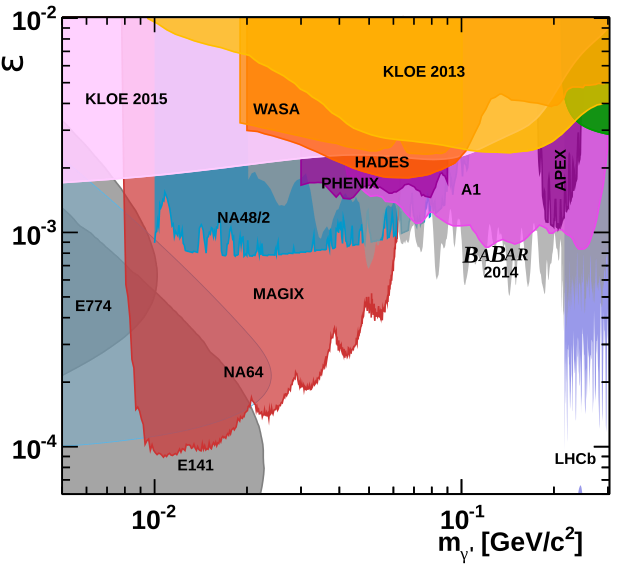
The existence of a dark photon as light but massive exchange particle, which couples to the sector of dark matter, is a well motivated extension of the standard model of particle physics. This particle could explain several astrophysical observations, like the observed positron excess at higher energies, but could also solve well known puzzles like the discrepancy of the anomalous magnetic moment of the muon.
An extensive program for the search for a dark photon is running at several accelerator laboratories, e.g. ⇒ MAMI and ⇒ JLAB. But also MESA with MAGIX can contribute to this search: in the low mass region! The high resolution of the spectrometers result in a similar high resolution for a dark photon, which would be produced radiatively in electron scattering off a heavy target nucleus and would decay in an electron positron pair.
Fig. 1 shows the exclusion limits which can be reached with the MAGIX spectrometers detecting the lepton pair for several different beam energies.
Furthermore it is possible to probe a second decay channel of the dark photon. If a rich dark sector exists with particles lighter than twice the mass of the dark photon it may decay to a dark matter pair (A′ → χχ). This may be detected as a peak in the missing energy spectrum. The extensive searches in the case of a massive dark photon left two windows unexplored according to ⇒ arXiv:2005.01515v3. One of these may be accesible by MAGIX.
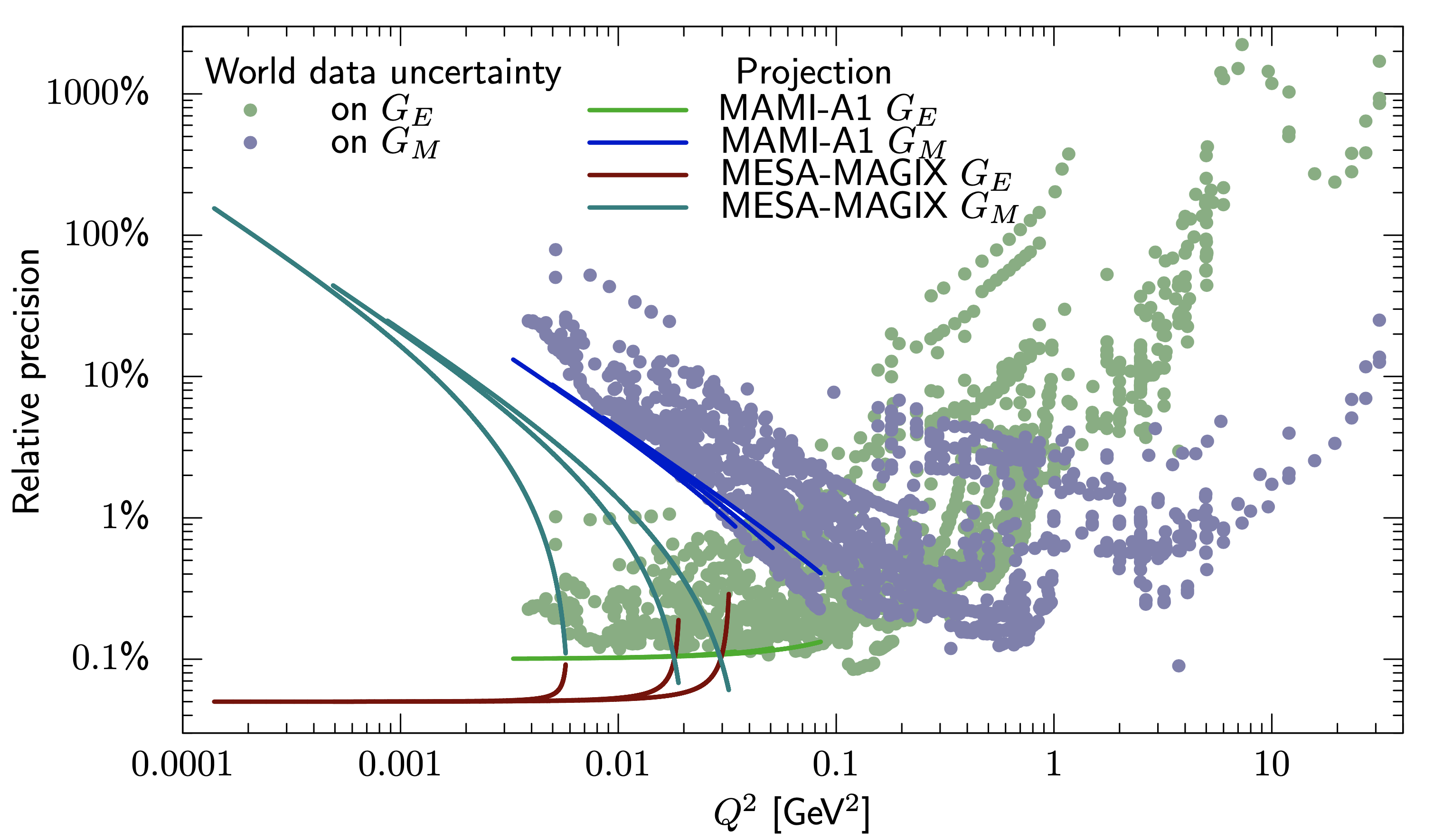
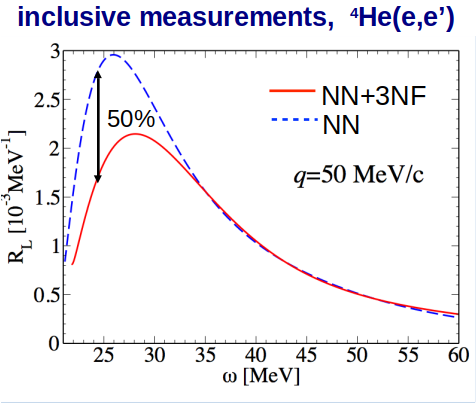
The distribution of electric and magnetic charge inside a nucleon is described by so-called form factors. They depend only on the four-momentum transfer Q2 of the exchanged virtual photon in elastic electron scattering.
The MAGIX spectrometer setup at the high-intensity electron accelerator MESA will be ideally suited to perform precision measurements of the proton form factors at small four-momentum transfers, reaching below Q^2=0.0001 GeV^2. The key element to the success of this type of experiment, aimed at a precise determination of the proton charge radius or its magnetic radius, is the absence of a target cell and the very low target density compared to a liquid target, minimizing the irreducible background and the effects of energy loss and multiple scattering.
The cross section for elastic electron-proton scattering is given by a mixture of the two form factors, with coefficients given purely by the kinematics. Measuring the same four-momentum transfer using different kinematics, i.e. with different scattering angle and beam energy, allows us to disentangle the form factors.
While suitable data are available over a wide range of four-momenta, the method is limited in the extraction of the electric form factor at large Q2, and of the magnetic form factor at small Q2, as their respective coefficients are then small compared to the coefficient of the other form factor - the cross section data is then not sensitive to that form factor. This is illustrated in Fig. 2: Here, the total cross section uncertainty of existing measurements is mapped to an uncertainty of the electric (GE) or magnetic (GM) form factor. As can be seen, at high Q2, the effective uncertainty on GE > 100 %, while GM is well measured. Vice versa, at small Q2, the data leads to uncertainties in the per-mille range for GE, but GM is only known to 10 %.
For a model independent extraction of the magnetic radius (and the so-called Zemach radius, another connection point to spectroscopy), accurate measurements of the low-Q2 behavior of the magnetic form factor is required. The MAGIX setup is ideal to provide measurements in this low-Q range.
Using lower beam energies to reach small Q2 values at backward angles maximizes the cross section sensitivity on GM, providing, for the first time, per-mille level accurate data on GM at Q2 below 0.04 (GeV/c)2 (turquoise lines in Fig. 2).
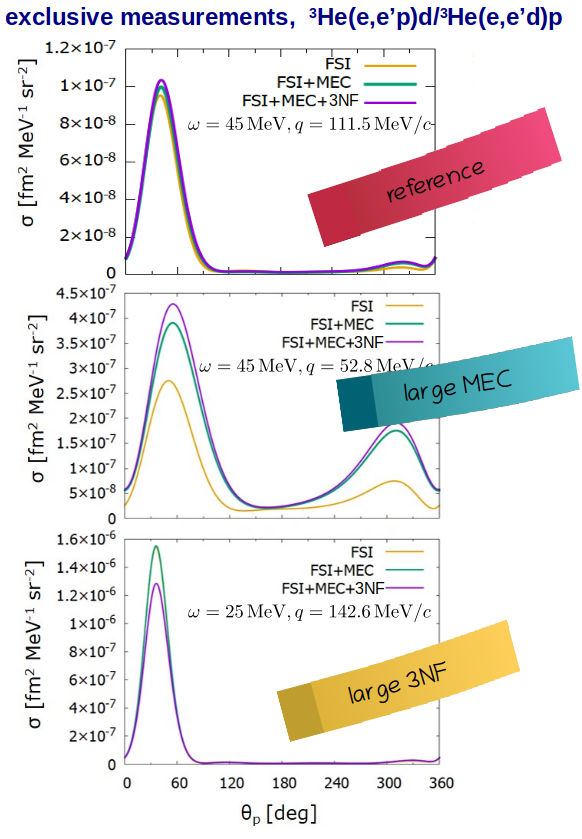
Atomic nuclei are built from quarks and gluons that are confined into
nucleons. At energies characteristic for nuclear binding the strength
and complexity of the underlying theory, Quantum Chromo Dynamics (QCD),
complicates immensely the understanding of nuclear phenomena in terms
of quarks and gluons as fundamental degrees of freedom.
However, considerable progress has been made to describe nuclei not
only by using phenomenological approaches, but starting from first
principles! Chiral effective field theories (χEFT), for instance, can
be used to describe the interaction between nucleons inside a nucleus.
The link to QCD is provided by obeying the relevant conservation laws
and symmetries of QCD in the low energy domain of nuclear few-body
systems.
A systematic verification of new theoretical developments can be
accomplished only in the low energy regime using precise experimental
data, for instance from studying the excitation of light nuclei with
electro-magnetic probes.
MESA's electron beam can be used as an electro-magnetic probe.
MESA's electron beam has low energy, below the pion production threshold.
MESA's electron beam intensity is huge.
The MAGIX jet-target provides various few-nucleon targets.
The MAGIX detector system provides high resolving power.
The MAGIX experiment provides ideal conditions to perform high-precision few-body physics studies!
By using different target nuclei, inclusive as well as exclusive
measurements will allow the systematic study of different aspects of
the theory. For the determination of a realistic three-body potential
(using nuclear forces and current operators as consistent as possible)
or the discrimination among different calculations, observables with
high sensitivity to three-nucleon forces (3NF) can be investigated (see Fig. 3).
Under different conditions effects from Meson Exchange
Currents (MEC) or Final State Interactions (FSI) can significantly be
enhanced and explored (see Fig. 4). The ultimate goal is clearly to
arrive at a precise, reliable and predictive understanding of the
interactions between nucleons.

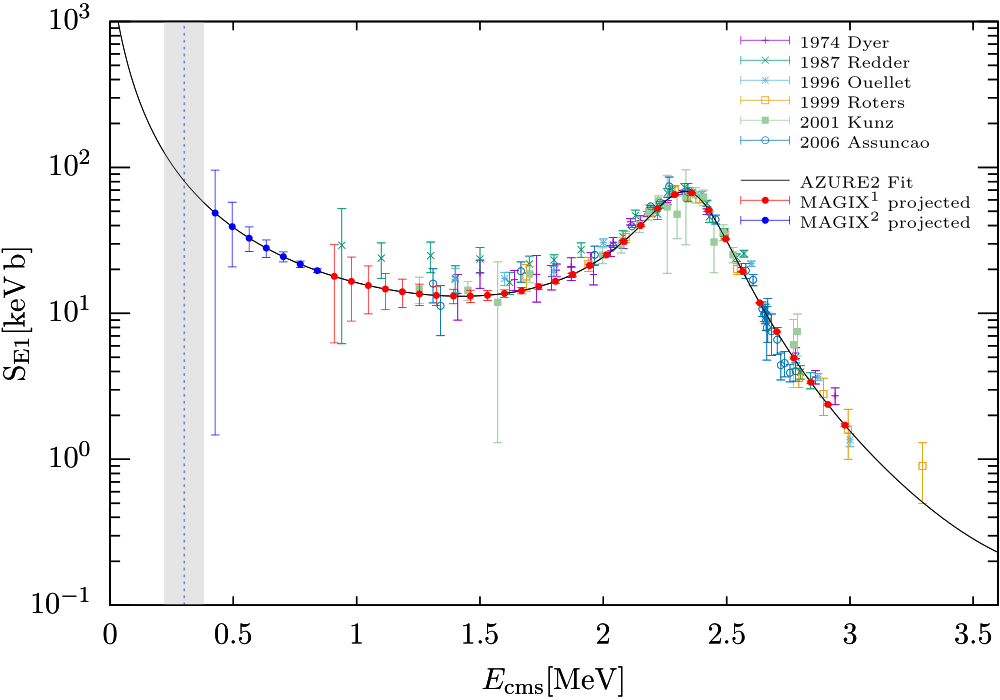
The nucleosynthesis process 12C(α, γ)16O has high astrophysical relevance, in particular to
model the ratio of carbon and oxygen abundance in stars.
The cross section as a function of the center-of-mass energy Ecms of such a process can be expressed as σ(Ecms) = 1/Ecms · e-2πη · S(Ecms), where η is the Sommerfeld number and S(Ecms), the so-called S-Factor, is a deviation factor from the simple tunnelling-barrier model and represents any effect due to the nuclear structure.
The measurement of the cross section is very demanding since the cross section drops dramatically at very low energies. Between
the lowest until now reached center-of-mass energy, 1 MeV, and the point of helium burning at 0.3 MeV, the cross section drops by nearly six orders of magnitude (see Fig. 5).
At MAGIX, an experiment is planned to determine the S-Factor of this reaction by measuring the electro-disintegration reaction 16O(e,e'α)12C. Electrons will be scattered inelastically on oxygen atoms. The scattered electrons and the produced α-particles will be detected in coincidence with the MAGIX setup. Finally, the S-Factor as a function of the center-of-mass energy of the 12C-α system can be determined from the electro-disintegration cross section. Even if the cross section of this reaction is higher by a factor of 50 (see Fig. 6), this is still a challenging measurement .
We will perform this measurement in three phases:
Given the promising simulation results (see Fig. 6, data points denoted as MAGIX1,2), MAGIX expects to make important contributions to the measurement of the S-Factor of the reaction 12C(α,γ)16O down to 0.5 MeV, exploring a new territory in nuclear astrophysics.
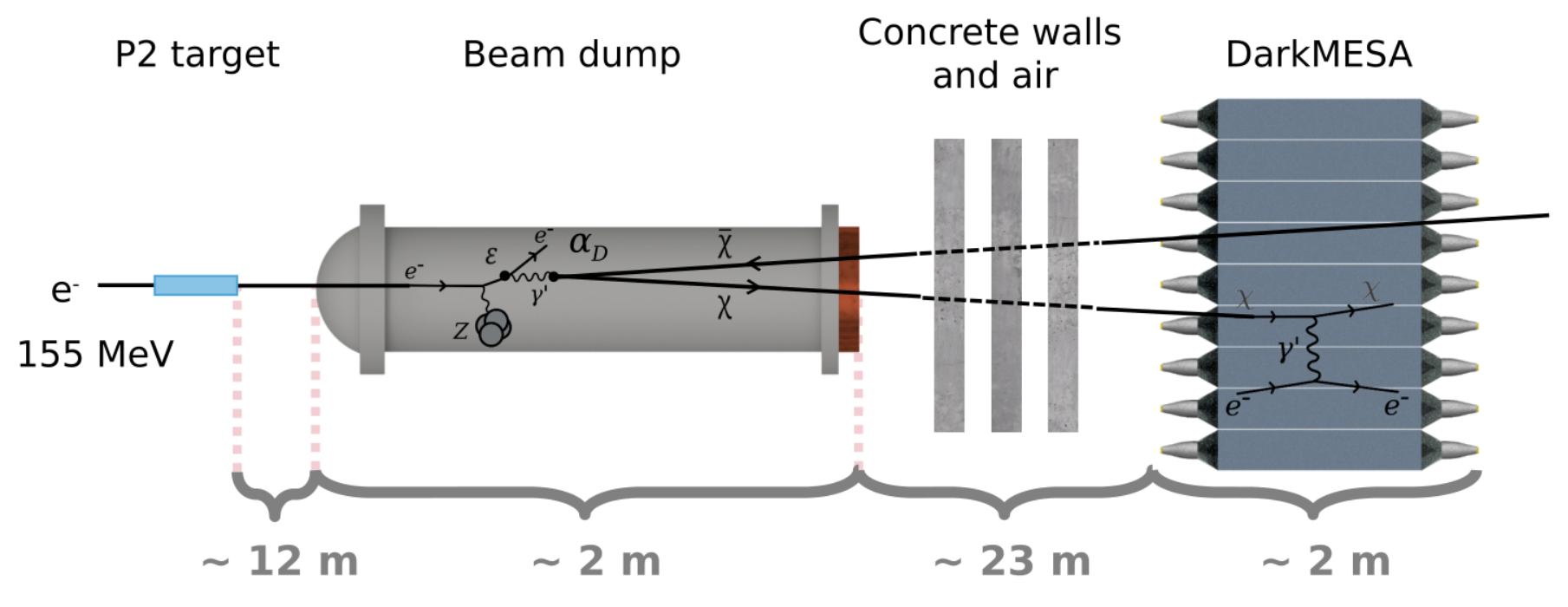
The experiments on direct detection of dark matter concentrate up to now on the detection of recoil signals from elastic scattering of dark matter particles from the galactic “Dark Matter Wind” with the detector material and have seen no confirmed signal up to now.
These kind of experiments is limited to the lower mass range by the minimal recoil energy of the target nucleus required to produce a detectable signal. One approach to overcome this limit is to produce dark matter particles with an accelerator. In this case, the recoil can be tuned by the accelerator energy and is considerable larger, requiring only much simpler detectors as for the direct detection experiments.
The reaction mechanism is the production via a dark photon which decays to light dark matter particles in a process analog to electromagnetic bremsstrahlung. In that case, stopping a beam of electrons always produces a collimated beam of dark matter particles. Such an experiment can be installed at MESA. In the extension of the beam axis and outside of the accelerator hall is a well shielded room, which is dedicated for the Cherenkov detectors of DarkMESA. With some probability, dark matter particles reaching these detectors can cause an electron recoil that results in a measurable signal. It has been shown that the extracted beam of MESA can be used for this experiment leading to a sufficient large number of particles-on-target.